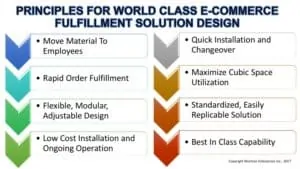The capability we had in E-Commerce order fulfillment was rather basic. We had employees manually pushing carts up and down standard warehouse racking aisles picking goods off of shelves. And when they had completed an order or a set of orders they would then push the entire cart back to a centralized order packing station.
As a Supply Chain Services company we needed a dramatically better capability if we were wanted to have customers trust their growing E-Commerce business with us. Pushing carts around a warehouse is both inefficient and lacks innovation.
We had to go back to the drawing board. But in doing so we would end up with a World Class solution!
The team had a plan to add some bells and whistles to the carts which would have been an improvement but it was totally inadequate. We also had customers asking us for an improved E-Commerce fulfillment solution, without which we would not get their business.
I was challenging the fundamental paradigms with respect to how basic E-Commerce fulfillment was conducted. Before we would implement a new E-Commerce fulfillment capability we needed a new set of principles. They would be imbedded in the design of the new Click to Ship process.

Move the material to the employees and not the other way around
As we discussed in our post ! it makes absolutely no sense to move your employees to the material. It takes too much time and it costs too much money. One of the elements of the Lean definition of waste is transportation and having your employees push carts to the material is highly wasteful.
The first principle in the design of a new E-Commerce fulfillment service capability was that we would move the material to the employees and not the other way around, and minimize any touching of the material.
Rapid order fulfillment was essential
E-Commerce customers want to receive the goods which they have ordered online to be delivered as quickly as possible. They do not necessarily want to pay for that service. Especially during the busiest time of the year (Black Friday/Cyber Monday) the solution had to support faster, not slower, order fulfillment.
Our second principle was that we needed a solution with unprecedented speed in order fulfillment. And we needed the system to work at this high speed without requiring the addition of labour.
Flexibility, modularity and adaptability must be built in to the CLICK TO SHIP design
We had numerous customers with a large variety of skus (in size and shape). Whatever solution we designed had to be able to simultaneously handle a large number and variety of skus. We needed to be able to adjust the system to handle variations in sku size dynamically with virtually no changeover time.
The overall system likewise had to be highly adjustable and modular. We needed to be able to add or reduce capacity rapidly and cost effectively without missing delivery of a single order.
Principle 3 was that we must design a system that was flexible, adjustable, and expandable (all cost efficiently and rapidly) for everything from supporting a single new sku to handling all demand fluctuations from any customer.
The Cost to install and operate the system had to be the lowest possible
Many companies spend millions and millions of dollars on highly automated fulfillment and sortation systems. Additionally there are many system designs which still involve a large amount of labour to operate and maintain. Both of these factors result in high cost systems.
Our objective was to invest in the requisite, but reasonable, amount of capital and automation that would allow us to achieve our other objectives without excessive spending in both investment and maintenance. Further we had to end up with a design that would result in the lowest possible cost/unit or cost/order to run the system.
The next principle was to design an advanced system which was both cost-effective from a capital investment standpoint and from an operating standpoint.
We required quick implementation, setup and changeover
We had a customer who was looking for a solution within 3-4 months. It provided the motivation for us to design a system which would not only be quick to install and get up and running from a standing start, but a system which was so modular that we could easily and quickly add new modules as customer demand required.
Further if a customer wanted us to introduce new skus, of various shapes and sizes, we needed the system to be able to accommodate these items instantly. And if a customer wanted to run a promotion of any kind we needed the process to be able to accommodate the merger of any combination of skus immediately.
Principle 5 required a system design that was so adaptable that we could implement any changes in minutes.
We needed to maximize our use of cubic space
In consideration of speed of operation, cost, and capacity utilization we wanted a system which took full advantage of the cubic space of the Distribution Centre. How many times have you seen fulfillment systems, especially those with eye level robotics or carts which occupy maybe 8-10 vertical feet of your facility leaving 20-30 vertical feet of un-utilized space above.
Even though these types of systems don’t use that empty cubic space you are paying for it if nowhere else than through the opportunity cost and lost capacity from this poor utilization.
Our next principle: we needed to take full advantage of cubic space in our Distribution Centre.
The CLICK TO SHIP solution must be standardized and easily replicated
Much of the engine that governs the operation of such a system is in the software developed by IT. Any time you make changes which require reprogramming to customize some element of your design you are adding phenomenal cost. Further this customization results in a different solution for customers as your system is replicated in various locations.
We wanted a standard set of software for running the system. It had to be designed with great flexibility so that we could accommodate any custom requirements a particular customer may have. However as we installed the system in various locations no single location would have the ability to customize the system for any local needs. If we were going to make changes we would have them globally and for everyone.
Our next principle required a flexible yet standardized IT platform. This would give us a low-cost solution yet still provide for a high-end capability.
We wanted an advanced, Best in Class, capability FROM CLICK TO SHIP
We needed a unique capability that would differentiate us in the marketplace. This did not mean we had to have advanced and extremely expensive robotics, but it did mean we needed to create a one of a kind solution using generally available supply chain technologies.
We had a lot of expertise across many industries and companies, including the competition. We knew to a great degree what other people were doing in this space as well as what the rest of our objectives were.
In the end of last principle was that we wanted to end up with a Best In Class capability. We knew that this is a moving target but we were going to make a dramatic leap forward in our capability.
With these principles in mind the team set out to design and implement our new E-Commerce Fulfillment capability. Within 4 months we had a new operating Click to Ship capability. It allowed us to have an order picked, packed and on the dock ready to ship within 4 minutes from the time the Distribution Centre received a customer order.
4 Minutes from Click to Ship … an absolutely remarkable achievement!
In the weeks and months that followed the team continued to make improvements to the Click to Ship capability. All of it was done quickly and cost effectively and in adherence to the original principles that we set out.
Customers, our employees, and visitors absolutely loved this new capability. We enabled customers to improve their time to market, lower their costs, improve their service levels. respond to any demand fluctuations, and maximize their sales and profitability.
We achieved our objective. We delivered a unique world class capability. And we didn’t break the bank doing it.

